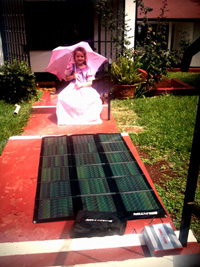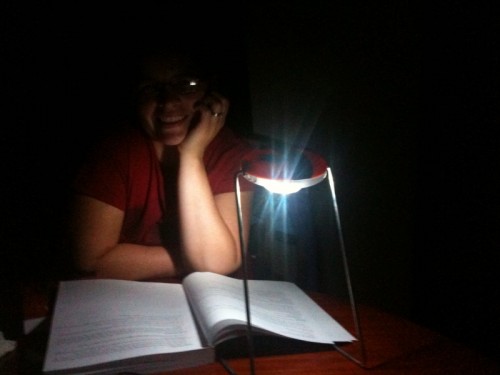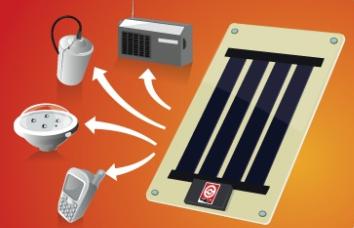 Reliable electricity in Kenya is an oxymoron. Last year’s rationing was up to 4 days per week in some parts of Nairobi, and with the low levels of water in the dam, it’s looking like 2010 won’t be such a bright year (pun intended…).
Reliable electricity in Kenya is an oxymoron. Last year’s rationing was up to 4 days per week in some parts of Nairobi, and with the low levels of water in the dam, it’s looking like 2010 won’t be such a bright year (pun intended…).
This is why I’m writing a post about solar power, which incidentally isn’t something I’m overly-well versed in, I usually leave this up to people like Afromusing. I did take the FLAP bags around Ghana, Kenya and Uganda earlier, but hadn’t started to truly delve into this arena until now. Before moving back, I picked up a Brunton Solaris 52solar power kit for my laptop needs. It has already proved indispensable.
Solantern
Joseph Nganga, a Kenyan businessman who I’ve known for a couple of years, has come back to Kenya and is taking the clean energy position firmly. He’s working with the World Bank on a plan for a “Cleantech Innovation Centre” in East Africa, and knows his way around both small- and large-scale renewable energy systems.
Right now he’s marketing and finding distributors for his Solantern product. It’s a Green Planet Lantern that is sold locally for 2000 Ksh ($25). His goal is to replace the unclean, and sometimes hazardous, kerosene lanterns that everyone uses in Kenya.
[Note: the electricity is off right now, and my wife is using one of Joseph’s Solanterns below]

An average Kenyan family spends 20 Ksh ($.25) on Kerosene every night, a total of $91 per year. There’s a real value buying a Solantern, and the light lasts for much longer than that 20 Ksh of Kerosene would (and it’s cleaner).
ToughStuff
Chance would have it, that on this power-challenged day, I would also meet up with Nick Sowden from ToughStuff. He’s here in Kenya to do for East Africa what they’ve already done for Madagascar: create an industry for entrepreneurs out of 1 watt solar panels.
 ToughStuff offers a large selection of accessories for their panel, with extensions like an LED lamp (530 Ksh/$7), phone connectors (75 Ksh/$1), a rechargeable powerpack (550 Ksh/$7.25) and fake D-cell batteries that take direct input from the panel – used to power radios. It’s a compelling mix, and you can tell why they’ve done so well in Madagascar, and which bodes well for them in East Africa as well.
ToughStuff offers a large selection of accessories for their panel, with extensions like an LED lamp (530 Ksh/$7), phone connectors (75 Ksh/$1), a rechargeable powerpack (550 Ksh/$7.25) and fake D-cell batteries that take direct input from the panel – used to power radios. It’s a compelling mix, and you can tell why they’ve done so well in Madagascar, and which bodes well for them in East Africa as well.
They’ve already started selling them through Chloride Exide in Kenya, at two shops in the industrial area you can pick up the kits for yourself. One shop is on Dunga Road, the other is on Kampala Road.
ToughStuff has a focus on entrepreneurs, which is why they have the “Buy One: Fund One” program. To entrepreneurs they offer financing through local MFIs.
Final Thoughts
Besides Solantern and ToughStuff, there are other projects like Portable Light (and others) working on low-cost solar for East Africa. It’s like the stars have aligned and all the cleantech companies are starting to really look at Africa as a place to make money – which it is.
The AfriGadget-side of me is waiting for local fundis to get their hands on these and to start customizing them for local needs. I want to see 8 ToughStuff solar panels daisy-chained together and used to power something larger. I want to see the wall-of-panels that light up 10 lights across a large room for night classes. The sort of thing that takes local needs, local technical talent and local businessmen to make happen.
Another thought… People think that these low-cost solar light kits are only for the poor. They’re wrong. I use them, as do many middle-class Kenyans if they can get their hands on them. The market is bigger than just the “bottom of the pyramid”.
Finally, I’m greatly pleased to see legitimate businesses, not NGOs, leading this charge. The quickest way to ruin this fledgling industry is by false ceilings imposed by development/aid subsidies around these products.